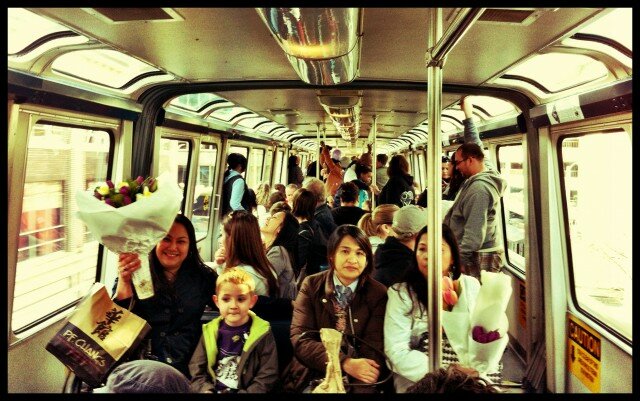
Tom Rasmussen, chair of the City Council’s Transportation Committee, “supports an amendment, drafted Tuesday, to delay a two-year Eastlake study to 2014 and to shift $1 million next year to help buses citywide,” reports Mike Lindblom in the Seattle Times. The study would compare bus rapid transit on Eastlake with a rapid streetcar line. This is all described in the city’s Transit Master Plan (Final Summary pdf), approved by the City Council, 9-0, in spring of this year:
Fairview/Eastlake Ave. E: Between the existing SLU terminus and the University Bridge, Fairview and Eastlake are consistently 5 lanes wide, and the center platform/center station configuration should work well. Transit could operate in mixed traffic or a dedicated lane. Few issues are anticipated assuming current peak direction parking restrictions on Eastlake are continued.
One reason “few issues are anticipated” is that Eastlake used to have a streetcar on it:
Eastlake’s excellent streetcar service encouraged the building of apartment houses, all lacking much on-site parking, as most of their tenants did not own a car. The apartments dating from 1900 to 1930 are generally of high quality inside and out, proportioned and landscaped not to overwhelm the neighboring homes or the streetscape.
Either way, BRT ($88 million estimated) or rail ($278 million), the new Eastlake line would have exclusive right-of-way, to avoid traffic congestion; stations would be farther apart, and fares would likely be paid at station kiosks, before boarding. A study would indicate whether a tram’s higher capacity was warranted. The TMP’s 2030 ridership estimate for the corridor is 25,000 for a streetcar, 20,000 for BRT.
Rasmussen, who recently rode on a crowded bus, thinks there’s nothing pressing about an Eastlake line, despite Amazon having just offered the city $5.5 million to pay, in part, for additional streetcar service in South Lake Union. The Seattle Streetcar carried 700,000 passengers in 2011–beating its forecasted ridership for that year by about 170,000. Now averaging over 15,000 riders per week, the streetcar was paid for half by federal, state, and local funds, half by a Local Improvement District (LID) tax on affected property owners.
You can’t find too many people who’d eliminate the service today, but in 2003, then-chair of the Council’s Transportation Committee, Richard Conlin, told the P-I: “‘I haven’t seen a groundswell. I haven’t had a single property owner contact me’ in support of the idea.” (Strategic thinking and the City Council often seem to be very distant relations.)
Despite the Eastlake corridor’s presence in a “final” Transit Master Plan, there’s no end to the armchair transit planning in Seattle, much of which recapitulates Rasmussen’s desire to buy transit fish today, rather than invest in high capacity lines for tomorrow. Seattle Transit Blog’s Bruce Nourish manages the trickier act of rebutting Rasmussen’s claim that Metro needs the money, while agreeing that an Eastlake streetcar may not be Job #1. Seattle Transit Blog’s Ben Schiendelman (also of Seattle Subway) has to point out that a lot more people work in South Lake Union these days, with more on the way:
People coming from all over the eastern half of the city would transfer from Link to this line to get to tens of thousands of new jobs in South Lake Union. Today, most of us don’t see that – we consider the South Lake Union Streetcar slow and infrequent, and we don’t see South Lake Union as a big urban center. But it’s not just Amazon’s new towers – there’s huge growth coming in SLU and more coming to the U-District shortly thereafter, and the focus on Eastlake ignores that this provides a connection between them – and a two way connection at that, as there are both jobs and residential in both centers.
Rasmussen’s attempt to punt the Eastlake decision until after the next mayoral election comes in the same week that Mayor McGinn announced the city has $850,000 in federal funds secured (with $900,000 pending final approval) for a study to extend the First Hill Streetcar line down Broadway past Denny. Originally intended to terminate at the Capitol Hill light rail station, the streetcar line would run another half-mile north (with three more stops), making Jerry Traunfeld, owner of Poppy, happy, along with other upper-Broadway business owners and the Seattle Asian Art Museum. Cost for the design and planning phase would total $3 million, construction about $25 million.
The First Hill streetcar will start carrying passengers in 2014; a construction period of about two years is the blink of an eye in rail-transit terms. In that context, Rasmussen’s delay of a year on the Eastlake line stands out.
